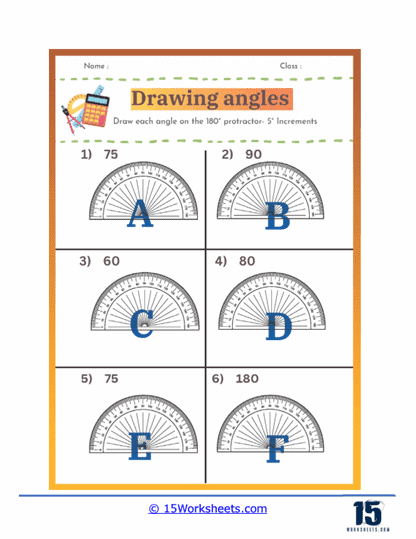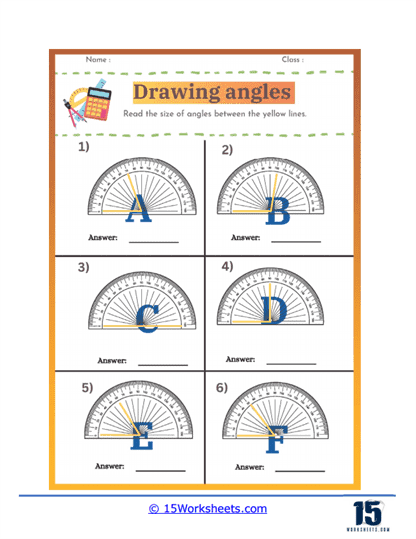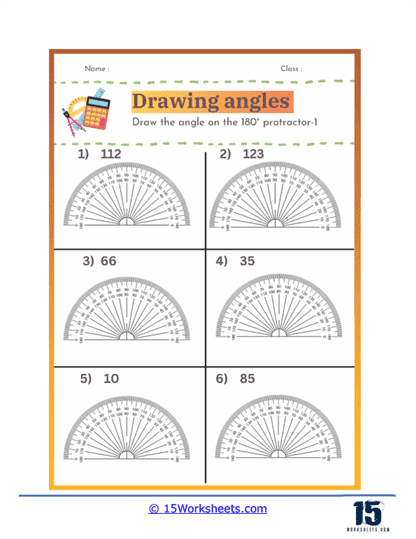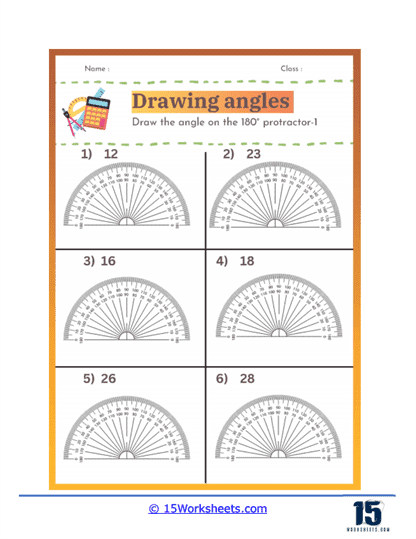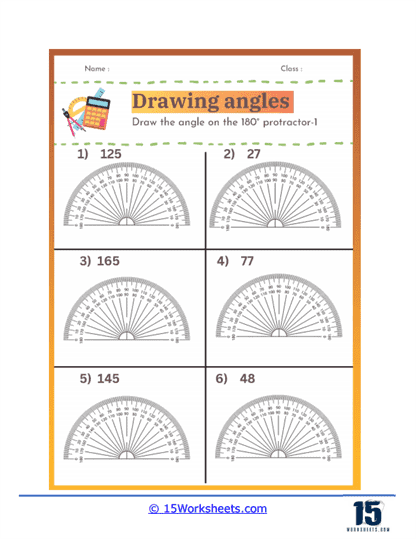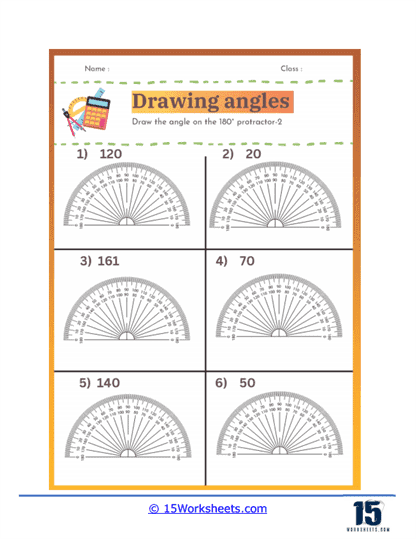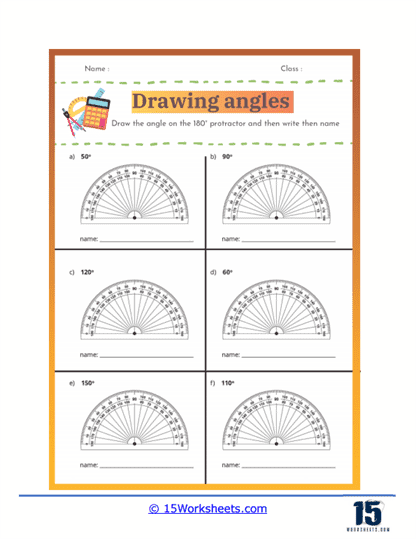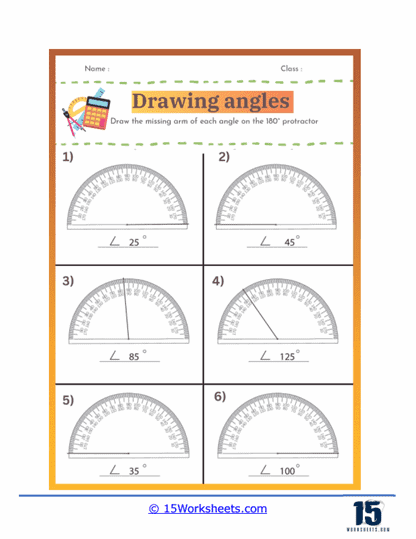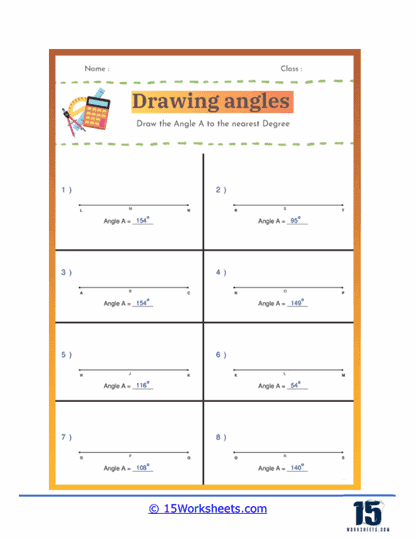Drawing Angles Worksheets
About These 15 Worksheets
These worksheets will help students understand and practice the measurement and construction of angles. These worksheets typically contain a variety of exercises that require students to use a protractor to measure given angles and to draw angles of specific measurements. The primary objective of these worksheets is to provide hands-on experience in handling protractors and developing a concrete understanding of angles, their types, and their properties. By engaging with these worksheets, students gain practical skills that are crucial for their mathematical development.
Math Skills Explored
These worksheets explore a range of fundamental math skills that are pivotal for students’ understanding of geometry. One of the key skills is the accurate use of a protractor, a tool that is essential for measuring angles. Students learn to align the protractor correctly with the vertex of the angle and read the measurements accurately.
These worksheets often include exercises that help students distinguish between different types of angles, such as acute, obtuse, right, and straight angles. By practicing these distinctions, students enhance their ability to classify angles based on their measurements.
Another critical skill developed through these worksheets is the ability to construct angles of specified measurements. This involves not only understanding how to measure angles but also how to replicate them accurately on paper. This skill is foundational for more advanced geometric constructions and proofs. Moreover, drawing angles worksheets help students grasp the concept of degrees as a unit of measurement for angles, reinforcing their understanding of how angles are quantified and compared.
Types of Exercises
Drawing angles worksheets typically offer a variety of exercises to reinforce students’ understanding and skills. Some common types of exercises include:
Measuring Given Angles – In these exercises, students are provided with angles drawn on the worksheet, and they are required to measure these angles using a protractor. This practice helps students become familiar with reading protractor scales and ensures they can measure angles accurately.
Drawing Specified Angles – These problems require students to draw angles of specific measurements using a protractor. For instance, the worksheet might instruct students to draw an angle of 45°, 90°, or 120°. This exercise reinforces the students’ ability to use a protractor for constructing precise angles.
Identifying Types of Angles – Some worksheets include exercises where students must identify whether an angle is acute, obtuse, right, or straight based on its measurement. This helps in developing their ability to classify angles correctly and understand their properties.
Completing Angle Drawings – In these problems, students might be given one arm of an angle and are asked to draw the other arm to create an angle of a specified measurement. This type of exercise challenges students to apply their knowledge practically and ensures they understand how to use a protractor for both measuring and drawing.
Angle Construction Challenges – More advanced worksheets might include complex problems where students have to draw multiple angles to create geometric shapes or solve problems involving angle sums. For example, students might be asked to draw a triangle with angles of 30°, 60°, and 90° or to construct a quadrilateral with given angle measurements.
Reading Protractor Exercises – These exercises involve providing students with images of protractors with angles already marked, and students must read the angle measurements. This type of exercise helps reinforce their ability to read and interpret protractor scales accurately.
Benefits of Learning How to Draw Described Angles
Enhancing Spatial Awareness
Learning how to draw an angle that is described to them significantly enhances students’ spatial awareness and visualization skills. When students interpret a verbal description of an angle and then translate that information into a precise drawing, they engage in a complex cognitive process that strengthens their ability to visualize geometric shapes and relationships in space. This skill is crucial not only in geometry but also in other fields such as engineering, architecture, and computer graphics, where the ability to envision spatial configurations is essential. By practicing this skill, students improve their mental rotation and spatial manipulation abilities, which are critical for understanding and solving complex geometric problems.
Attention to Detail
Drawing angles accurately requires a high level of precision and attention to detail. Students must carefully measure angles using protractors and ensure that their drawings reflect the exact specifications given. This practice helps students develop meticulous habits and a keen eye for accuracy, which are valuable skills in both academic and professional contexts. Precision is particularly important in fields such as drafting, engineering, and design, where even minor errors can have significant consequences. By mastering the skill of drawing described angles, students learn to approach tasks with a methodical and careful mindset, ensuring that their work meets high standards of accuracy.
Strengthening Understanding of Geometric Concepts
When students draw angles based on descriptions, they reinforce their understanding of geometric concepts and relationships. This hands-on activity allows them to apply theoretical knowledge in a practical context, deepening their comprehension of angle properties and how angles interact within geometric figures. For example, students learn how to use angle bisectors, understand complementary and supplementary angles, and explore the relationships between adjacent and vertical angles. By actively engaging with these concepts through drawing, students solidify their understanding and improve their ability to recall and apply geometric principles in various contexts.
Enhancing Problem-Solving Skills
Drawing angles from descriptions is an excellent way to enhance problem-solving skills. This task requires students to interpret information, plan their approach, and execute their drawing with precision. It encourages analytical thinking and the ability to break down complex instructions into manageable steps. This process is similar to solving geometric problems, where students must identify the given information, determine the relationships between elements, and apply appropriate methods to find solutions. By practicing drawing angles, students develop a systematic approach to problem-solving that can be applied to a wide range of mathematical and real-world challenges.
Building Confidence in Mathematical Abilities
Successfully drawing described angles can greatly boost students’ confidence in their mathematical abilities. As they become more proficient in interpreting descriptions and producing accurate drawings, students gain a sense of accomplishment and confidence in their skills. This positive reinforcement encourages them to tackle more challenging problems and explore advanced geometric concepts. Confidence in mathematics is crucial for academic success, as it motivates students to engage with the subject, persist through difficulties, and strive for mastery. By mastering the skill of drawing angles, students build a solid foundation for continued success in mathematics.
Encouraging Independent Learning
Learning to draw angles from descriptions encourages independent learning and self-reliance. Students must rely on their own understanding and skills to complete the task, fostering a sense of autonomy and responsibility for their learning. This independence is important for developing lifelong learning habits and the ability to tackle new challenges without constant guidance. By practicing drawing angles, students learn to trust their abilities, seek out resources when needed, and persevere through difficulties, all of which are essential traits for academic and professional success.
Real-World Applications
Understanding how to draw described angles has numerous real-world applications and practical benefits. In professions such as architecture, engineering, and construction, precise angle measurements are crucial for designing and building structures. For example, architects must accurately draw angles to create blueprints, while engineers need to ensure that components fit together correctly. In everyday life, this skill can be useful for tasks such as home improvement projects, where precise measurements are necessary to ensure that parts fit together seamlessly. By learning to draw angles accurately, students acquire practical skills that are valuable in both professional settings and daily activities.
Drawing angles is a fundamental skill in geometry that extends far beyond the classroom, finding applications in numerous real-world contexts. In architecture and construction, the precise measurement and drawing of angles are essential for designing buildings, ensuring structural integrity, and creating aesthetically pleasing structures. Architects use angles to draft blueprints and floor plans, while construction workers rely on these measurements to execute the designs accurately. For instance, when creating a staircase, the angles of each step must be precisely calculated to ensure safety and functionality. Similarly, in carpentry, cutting wood at specific angles is crucial for constructing furniture and other items that fit together correctly.
Students encounter drawing angles in everyday life through various practical activities. For example, when assembling furniture, they often need to align parts at specified angles. DIY projects, such as building shelves or crafting, require understanding how to measure and draw angles to ensure pieces fit together seamlessly. In sports, particularly in activities like basketball or billiards, understanding angles can improve performance. Players must calculate the angles of their shots to achieve the desired trajectory and outcome. This demonstrates how geometry is integral to both recreational and practical tasks, enhancing problem-solving skills and spatial awareness.
Learning to draw angles also enhances students’ analytical and critical thinking skills. When students engage in exercises that involve measuring and drawing angles, they develop precision and attention to detail. These skills are transferable to other academic subjects and future careers. For example, in science, understanding angles is crucial in fields such as physics and engineering, where accurate measurements are vital for experiments and designing machinery. In art, knowledge of angles contributes to perspective drawing, allowing artists to create realistic and proportionate works.
The skills learned through drawing angles contribute to personal development and practical decision-making. For instance, when planning home renovations or designing gardens, individuals use their understanding of angles to maximize space and achieve desired aesthetics. In fashion design, drawing angles is essential for creating patterns and ensuring garments fit correctly. This illustrates how geometry intersects with creativity, enabling individuals to bring their ideas to life accurately.

